LEARNING TO APPLY TAIJIQUAN IN FREE SPARRING IN 3 DAYS!
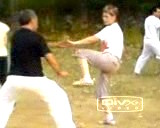
These video were taken impromptu during a regional Taijiquan course on 15th, 16th and 17th August 2005 in Soria, Spain where most of the participants had no previous martial art experience. Yet, within three days, they could apply typical Taijiquan techniques and skills to defend themselves, often at opponents who were much bigger and stronger.
More significantly, not only no one was hurt in the sparring, all of them enjoyed themselves. Their Taijiquan, practiced as chi kung, also helps them to overcome pain and illness, increase vitality and mental freshness, and experience happiness and inner peace. Many people may find this hard to believe, but it is true.
The main reason for releasing these video clips is to show that Taijiquan can be used for combat and this ability can be attained within a relatively short time. We hope these video clips may prove to be useful to Taijiquan practitioners regardless of their schools or styles. If you wish to raise any questions or comments, please do so at the Shaolin Wahnam Institute Virtual Kwoon and Discussion Forum.
The video clips below show the training lessons as they were, without any pre-arrangement or editing. The video clips are arranged in the order the lessons progressed so that those interested may have some ideas how beginners could train themselves in three days to use Taijiquan for combat.
The course took three days, with four hours non-stop in the morning and three hours non-stop in the evening each day.
On the first day students practiced the fundamentals of Taijiquan, namely stances, footwork and basic Taijiquan pattterns. You could see that some of the students were awkward at the beginning. On the second day they practiced “Pushing Hands” and developed fundamental combat skills. On the third and final day they practiced “Striking Hands” and applied their skills and techniques to sparring. You could see a marked difference in their performance between the first day and the last day of their training.
Stance Training

Stance training or "zhan zhuang" is very important in Taijiquan and all other styles of kungfu. It develops internal force and builds the foundation for all subsequent training. A main reason why participants of this course progressed so fast was our emphasis on stance training.
The stance they performed in the video was the Horse-Riding Stance, with their both open palms at breast level. This particular pattern is called "Carrying the Sun and Moon". The person performing the stance in front was Professor Inaki Rivero Urdiain, a Shaolin Wahnam instructor in San Sebastian, Spain.
We are sorry that this video clip is quite short as the video recording was impromptu and that we do not have other video clips to show other stances. Despite it being short we post this video clip to emphasize the importance of stances in our training.
Practicing White Snake Shoots Venom
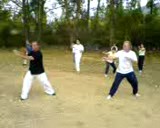
This video clips shows students practicing a basic set in Wahnam Taijiquan called "White Snake Shoots Venom". They learned this Taijiquan set in one day. In our school, Shaolin Wahnam, it is a norm that students learn a set in a very short time. This is possible because they spent much time on the basics, like stances, footwork and basic patterns.
"White Snake Shoots Venom" is the first of our combat application set in Wahnam Taijiquan. It comprises three combat sequences, which the students will use later in their combat application. The students were relaxed when performing the set, and they went into chi flow after it.
Pushing Hands -- Size is Not a Crucial Factor
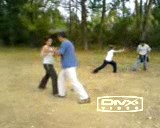
"Pushing Hands" is an important aspect of Taijiquan training where valuable combative skills are developed. Among the important combative skills learnt are being relaxed while pushing hands, sensing the opponent's intentions, and following the opponent's movements.
It is interesting to note in this video clip that smaller sized women were pushing hefty men away. This was possible if the women knew how to apply the Taijiquan principle of "pushing from the back leg, controlled by the waist, and finishing at the hands".
Pushing Hands — Fun and Laughter
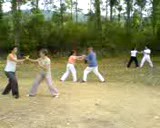
Besides developing valuable skills, "Pushing Hands" can be full of fun and laughter. Here the students learned that with proper skills and footwork, they could neutralize the powerful push of opponents bigger and stronger than them.
When one observes closely, he may also notice that there was a marked improvement of the students' skills in this video clip over earlier video clips.
Pushing Hands -- Skills and not Brute Strength
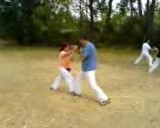
It is worthy of note that while smaller sized women were pushing hefty men away in an earlier video clip, this video clip shows it was not easy for hefty men to push smaller sized women away if the women were skillful. Towards the end of the video clip, Carlos pushed Ana away. Take note that this successful push was not due to his superior strength but due to his superior skills.
If Ana was more skillful, she could also push Carlos away although she might be physically weaker. Such skills developed in "Pushing Hands" are crucial in Taijiquan combat application whereby a physically weaker and smaller sized exponent can defeat an opponent who is physically stronger and bigger in size.
Combat Application -- White Snake Shoots Venom (Part 1)

After having developed some combat skills, the course participants used these skills on techniques for combat application. This video clips shows Carlos and Manuel applying the pattern "White Snake Shoots Venom" for combat. This is a deadly technique as the palm thrust goes through the opponent's throat from front to back.
But internal force generated by chi flow, and not brute strength, is used in the attack. As an opponent strikes with "White Snake Shoots Venom", the exponent deflects it away following its momentum and counter strikes also with “White Snake Shoots Venom”.
Combat Application -- White Snake Shoots Venom (Part 2)
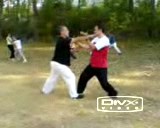
This video clip is a progression from the previous one, where the exponent used another "White Snake Shoots Venom" to counter an opponent's "White Snake Shoots Venom". In the earlier video clip, the counter strike was initiated by deflecting the opponent's attack. Here, the counter strike was initiated by "opening" the opponent's attack, and striking him when he least expected it.
Combat Application -- Low Stance Vertical Punch
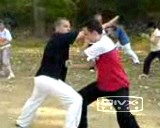
The "White Snake Shoots Venom" attack shown in the previous video clip was formidable, and often caught an opponent by surprise. An effective counter was “Low Stance Vertical Punch”. Deflect the opponent's palm thrust following its momentum, and simultaneously counter-attack with a low vertical punch, striking the opponent at a time when he thinks he has struck you.
Practicing Kicks Against an Imaginary Opponent
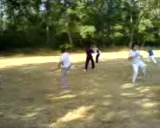
Kicks and their counters form an important part of Taijiquan training. This video clip shows students practicing kicks against imaginary opponents. As there are some innate weaknesses in kicks, one must practice kicking to be proficient before using them. He must also understand how an opponent is likely to respond to his kicks.
Striking Tiger, an Excellent Taijiquan Counter Against Kicks
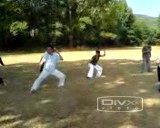
An excellent Taijiquan pattern to counter kicks is "Striking Tiger Poise". It can be used against any kicks! But knowing its application is one thing, being able to apply it effectively is another.
To attain effective application, one must practice the technique correctly over and over again many times so that when an opponent kicks, he can apply it spontaneously. Here the students practiced the technique against an imaginary opponent executing a kick.
Developing Comradeship in Sparring Practice
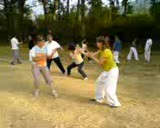
Practicing sparring among classmates should not cause hurt to one another, and should not be brutal. In fact, sparring is an excellent way to develop comradeship.
This video clip, taken impromptu at the regional Taijiquan course in Spain in August 2005, shows students discussing among themselves and helping one another. When practicing with a sparring partner of a lower standard of skills, the senior partner should purposely slow down to help the other. Sparring is not fighting; it should be fun and educational.
Discussing Taijiquan Philosophy

Besides practical work, students also spent some time discussing the philosophy of Taijiquan. Grandamster Wong answered a question on how best to practice at home, mentioning that they could practice a Taijiquan set to correct their forms, combat sequences to enhance their combat efficiency, and stance training to develop internal force. He also said that when they practiced they should make every one of their movements a piece of art.
Taijiquan Felling Techniques -- Carry Tiger Back to Mountain
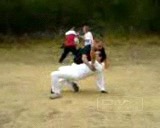
Some people may be surprised that felling an opponent forms an important part of Taijiquan training. Here students at a regional Taijiquan course in Spain in August 2005 used the pattern "Carry Tiger Back to Mountain" to fell their opponent. A good stance is needed to execute this felling technique effectively.
You must also let your sparring partner fall gently onto the ground, without hurting him (or her). The sparring partner must know how to fall safely. His palm must be the last, not the first, to touch the ground when he falls. If he tries to stop his fall with his hand, as many untrained persons instinctively do, he may break his hand.
Counters against Felling Attacks -- Black Bear Sinks Hips
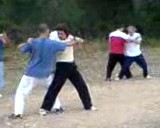
An excellent counter against an opponent using “Carry Tiger Back to Mountain” to fell you, is the pattern “Black Bear Sinks Hips”. It is so simple that many people may not believe that it works. This application indeed excellently expresses the essence of Taijiquan, where skill not brute strength decides the outcome of combat.
Gripping Attacks and their Counters
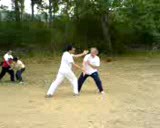
As a complete art, Taijiquan covers all the four categories of attack, namely striking, kicking, felling and gripping. What would you do if your opponent grips you with one hand to put you in an awkward position, and simultaneously strikes you with his other hand. This video clip shows some examples.
Beginning Stage of Free Sparring

This video shows students at the start of their free sparring session. We call this free sparring because students at this stage are free to use whatever techniques or movements they like in the sparring. Earlier their sparring was pre-arranged or defined by certain conditions, such as using only hand strikes.
It was only sensible and logical that they chose to use what they had learnt. It was understandable that their movements were slow and not powerful. Most of them were new to martial arts, and they did not have any experience of free sparring before. It was significant and inspiring that even when they free sparred the first time, they could use typical Taijiquan patterns.
It was even more significant and inspiring that they did not hurt one another, and that there was much laughter and comradeship. All the videos are taken impromptu without any prior arrangement.
